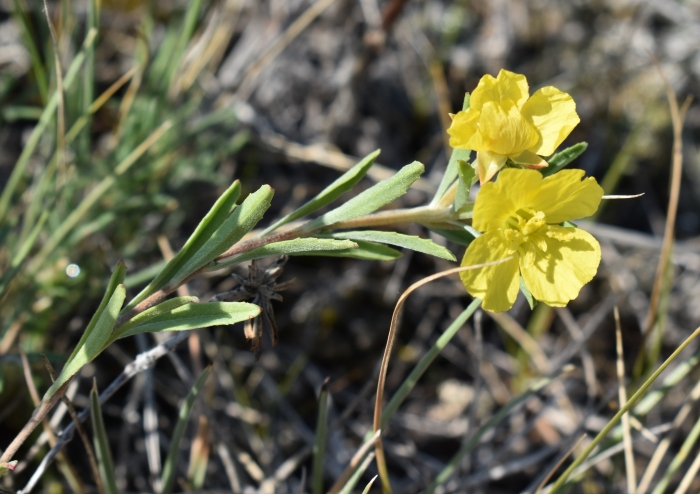Yellow Sundrops
(Oenothera serrulata)
Yellow Sundrops (Oenothera serrulata)
/
/

Eric Lamb
CC BY 4.0
Image By:
Eric Lamb
Recorded By:
Copyright:
CC BY 4.0
Copyright Notice:
Photo by: Eric Lamb | License Type: CC BY 4.0 | License URL: http://creativecommons.org/licenses/by/4.0/ | Rights Holder: Eric Lamb | Publisher: iNaturalist | Date Created: 2021-07-05T09:53:09-07:00 |

























Estimated Native Range
Summary
Oenothera serrulata, commonly known as Yellow Sundrops, is a perennial subshrub native to dry, open plains and prairies across central North America, including regions of central Canada and the central United States. It is particularly adapted to thrive on various substrates, such as limestone and gypsum. Yellow Sundrops typically grow up to 18 inches tall and feature narrow, toothed leaves. The plant is known for its bright yellow flowers that bloom from March to November, opening in the morning and closing by the afternoon, with the blooms eventually fading to orange or pink. The flowers are quite showy and attract pollinators such as bees and butterflies.
Yellow Sundrops are valued for their extended blooming period and drought tolerance, making them suitable for xeriscaping and rock gardens. They are also used in border plantings and wildflower meadows. This plant prefers full sun and can tolerate a range of soil types, provided they are well-drained. While generally low-maintenance, it is important to avoid overwatering to prevent root rot. Yellow Sundrops can self-seed prolifically, which should be considered when planting in smaller gardens to prevent unwanted spread.CC BY-SA 4.0
Yellow Sundrops are valued for their extended blooming period and drought tolerance, making them suitable for xeriscaping and rock gardens. They are also used in border plantings and wildflower meadows. This plant prefers full sun and can tolerate a range of soil types, provided they are well-drained. While generally low-maintenance, it is important to avoid overwatering to prevent root rot. Yellow Sundrops can self-seed prolifically, which should be considered when planting in smaller gardens to prevent unwanted spread.CC BY-SA 4.0
Plant Description
- Plant Type: Shrub
- Height: 1-3 feet
- Width: 1-2 feet
- Growth Rate: Moderate
- Flower Color: Yellow
- Flowering Season: Summer
- Leaf Retention: Semi-deciduous
Growth Requirements
- Sun: Full Sun
- Water: Medium
- Drainage: Fast
Common Uses
Bee Garden, Butterfly Garden, Drought Tolerant, Low Maintenance
Natural Habitat
Dry, open plains and prairies with various substrates, including limestone and gypsum
Other Names
Common Names: Serrulate Evening Primrose, Velvetweed, Serrate-Leaved Evening-Primrose, Half-Shrub Calylophus, Half-Shrub Sundrop, Plains Yellow Primrose, Shrubby Evening-Primrose, Toothed Primrose
Scientific Names: , Oenothera serrulata, Calylophus australis, Calylophus drummondiana, Calylophus drummondianus subsp. drummondianus, Calylophus drummondii, Calylophus drummondii, Calylophus nuttallii, Calylophus serrulata, Calylophus serrulata var. arizonicus
GBIF Accepted Name: